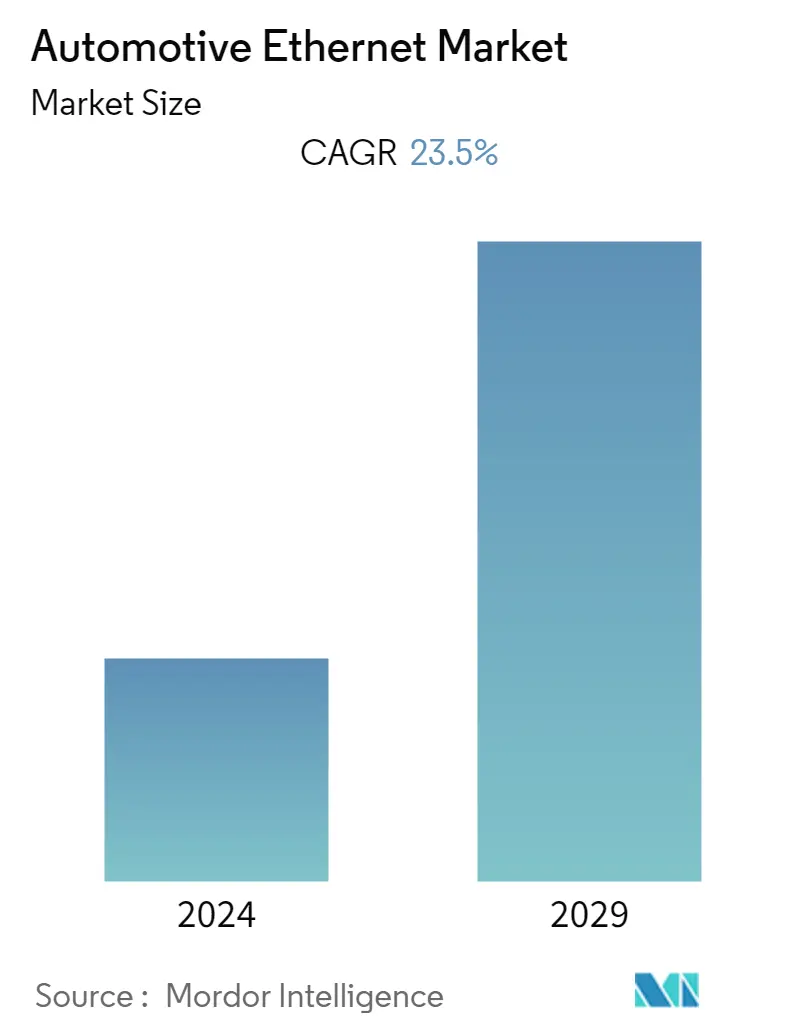Market Size of Automotive Ethernet Industry

| Study Period | 2019 - 2029 |
| Base Year For Estimation | 2023 |
| CAGR | 23.50 % |
| Fastest Growing Market | North America |
| Largest Market | North America |
| Market Concentration | Low |
Major Players
*Disclaimer: Major Players sorted in no particular order |
Automotive Ethernet Market Analysis
The automotive ethernet market is expected to reach a CAGR of 23.5% during the forecast period. An ethernet network with a physical layer customized for usage in the car industry is known as automotive ethernet. Utilizing modern Phy transceivers provides a system that can meet vehicle electromagnetic compatibility and immunity standards, lowering the cost of cable.
- The increased deployment of Advanced Driver Assistant System (ADAS), infotainment, rapid progress in the development of autonomous vehicles, and the low cost of ethernet has led to the immense growth of automotive ethernet as it serves the purpose of connecting in-vehicle electronic system efficiently as compared to traditional harness.
- Automotive ethernet offers connectivity across automotive applications, such as powertrain, chassis, body and comfort, ADAS, and infotainment systems. Supporting high bandwidth applications operating at high or low speed addresses the challenges designers and engineers face in integrating different systems.
- Ethernet tends to bypass traditional cabling for connectivity, allowing all vehicle components to connect with lighter and more effective wires. This alone has enabled manufacturers to reduce connectivity costs by 80% and cabling weight by 30%. This also serves as a potential application for the cost-effective development of a connected car.
- High-performance navigation systems, high-end entertainment, and telematics require the system to remain 'always on' in a connected car. The increasing bandwidth for in-vehicle data communications has driven the ethernet deployment market.
- With the recent outbreak of COVID-19, the automotive ethernet market is witnessing a decline in growth in the short run due to major automotive manufacturing plants having stopped their production in response to the lockdown being enforced by many countries across the world.
Automotive Ethernet Industry Segmentation
Automotive ethernet is a physical network used to connect various components in a vehicle with the help of a wired network. It is designed to meet electrical and bandwidth requirements. This arrangement reduces the cost of cabling and labor required by attaining synchronization, thereby reducing the network's complexity within the vehicle. The report provides a detailed analysis of the components used in various vehicle types and a detailed regional analysis. Moreover, the qualitative trends for the bandwidth, such as 10Mbps, 100Mbps, 1Gbps & beyond, and application-related trends related to ADAS, infotainment, powertrains, chassis, etc., are incorporated in regional analysis.
The automotive ethernet market is segmented by components (hardware, software, and services) and geography (North America, Europe, Asia Pacific, Latin America, and Middle East & Africa).
The market sizes and forecasts are provided in terms of value (USD million) for all the above segments.
| By Component | |
| Hardware | |
| Software and Services |
| Geography | |
| North America | |
| Europe | |
| Asia-Pacific | |
| Latin America | |
| Middle East and Africa |
Automotive Ethernet Market Size Summary
The automotive ethernet market is experiencing significant growth, driven by the increasing deployment of Advanced Driver Assistance Systems (ADAS), advancements in autonomous vehicle technology, and the cost-effectiveness of ethernet solutions. Automotive ethernet, designed specifically for the automotive industry, offers enhanced connectivity across various vehicle applications, including powertrain, chassis, body, comfort, ADAS, and infotainment systems. By replacing traditional cabling with ethernet, manufacturers can reduce connectivity costs and cabling weight, facilitating the development of connected cars. The demand for high-performance navigation, entertainment, and telematics systems, which require constant connectivity, further propels the adoption of automotive ethernet. However, the market faced short-term challenges due to the COVID-19 pandemic, which disrupted automotive production globally.
The market is poised for robust growth, particularly as the number of vehicles equipped with autonomous driving features increases. Ethernet's role in connecting sensors and components for efficient data transfer is crucial for the development of HD maps used in autonomous driving. The rise of IoT solutions in the automotive sector, along with the emergence of connected vehicles, is driving the adoption of ethernet, enhancing the capabilities of ADAS and V2X systems. Government regulations mandating safety features also contribute to market expansion. The Asian-Pacific region, especially India, is witnessing increased production of passenger vehicles, with automakers expanding manufacturing capacities to meet local demand. Despite the fragmented nature of the market, characterized by high competition and regulatory requirements, key players like Broadcom Inc., NXP Semiconductors NV, and Marvell Technology Group Ltd are driving innovation and strategic partnerships to strengthen their market positions.
Automotive Ethernet Market Size - Table of Contents
-
1. MARKET DYNAMICS
-
1.1 Market Overview
-
1.2 Industry Value Chain Analysis
-
1.3 Industry Attractiveness - Porter's Five Forces Analysis
-
1.3.1 Bargaining Power of Suppliers
-
1.3.2 Bargaining Power of Consumers
-
1.3.3 Threat of New Entrants
-
1.3.4 Threat of Substitutes
-
1.3.5 Intensity of Competitive Rivalry
-
-
1.4 Market Drivers
-
1.4.1 Increased Demand for Infotainment and ADAS
-
1.4.2 Rapid Adoption of Low cost Ethernet Technology
-
-
1.5 Market Restraints
-
1.5.1 Interoperability Among Components and Application Computability
-
-
1.6 Assessment of Impact of Covid-19 on the Industry
-
-
2. MARKET SEGMENTATION
-
2.1 By Component
-
2.1.1 Hardware
-
2.1.2 Software and Services
-
-
2.2 Geography
-
2.2.1 North America
-
2.2.2 Europe
-
2.2.3 Asia-Pacific
-
2.2.4 Latin America
-
2.2.5 Middle East and Africa
-
-
Automotive Ethernet Market Size FAQs
What is the current Automotive Ethernet Market size?
The Automotive Ethernet Market is projected to register a CAGR of 23.5% during the forecast period (2024-2029)
Who are the key players in Automotive Ethernet Market?
Broadcom Inc., NXP Semiconductors NV, Marvell Technology Group Ltd., Microchip Technology Inc. and Texas Instruments Inc. are the major companies operating in the Automotive Ethernet Market.

